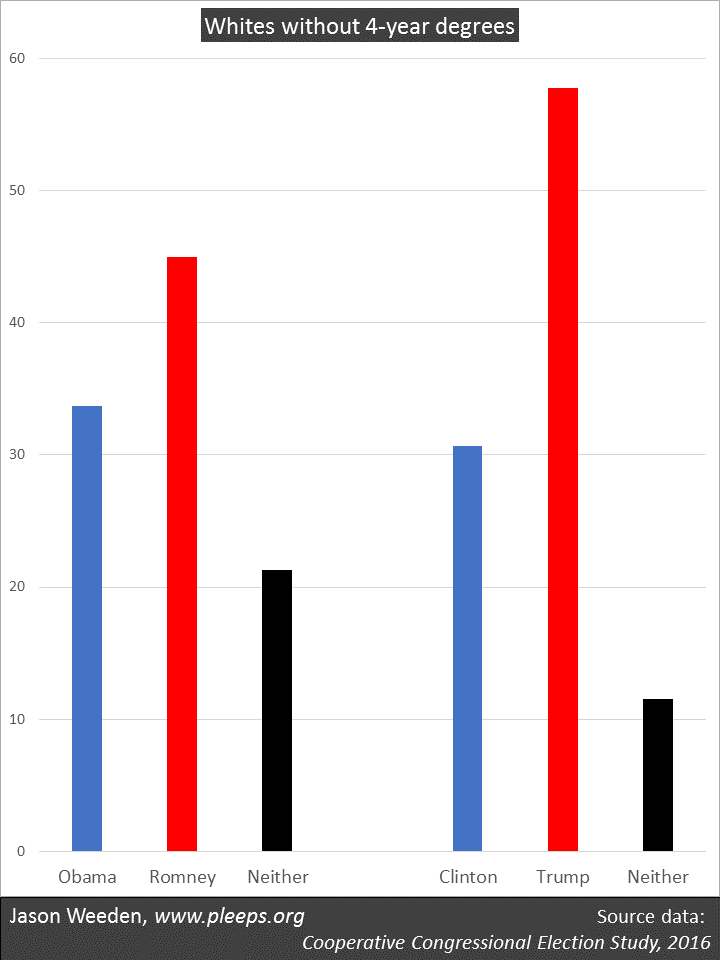According to exit polls from the 2016 presidential race, Trump did especially well with whites who don’t have 4-year college degrees. The polls showed Trump with a 37-point advantage over Clinton (66 to 29) among these folks, which was a real increase from Romney’s 25-point advantage over Obama (61 to 36). In addition, various state-level and county-level analyses have pointed to locations in which there are lots of non-degreed whites as those where Trump tended to outperform Romney’s numbers.
This has led some observers to talk about how Trump converted large numbers of former Obama voters—for example, the often-repeated claim the Trump won lots of folks who “voted for Obama twice.” Yet that’s getting ahead of the data. If it were the case that the exact same people voted in 2016 as in 2012, then it would be a safe assumption that lots of non-degreed whites who voted for Obama turned around and voted for Trump. But they weren’t the exact same people. Some folks who voted in 2012 sat out 2016. Some 2016 voters had previously not voted in 2012.
So where did Trump’s increased margin come from? Surely it involved a mix of converted Obama voters and former non-voters. But what’s the breakdown? Which was the bigger deal?
With the release on Friday of the 2016 Cooperative Congressional Election Study (CCES), we’ve got new data that provides an estimate. The 2016 CCES asked its respondents in its pre-election survey whether and for whom they had voted in 2012, and then asked those same folks in its post-election survey whether and for whom they had voted in 2016. This allows us to see not just margins among those who turned out, but also patterns of non-voting. I limited the sample to those old enough to vote in 2012 and who reported both their 2012 and 2016 votes (or non-votes).
The first chart below shows the basic percentages. According to the respondents’ recollections, in 2012 around 34% voted for Obama, 45% voted for Romney, and the other 21% voted for neither (most of these folks didn’t vote at all, but some reported voting for third-party candidates or not being able to recall). In 2016, 31% reported voting for Clinton, 59% for Trump, and 11% for neither. Thus, Trump’s gains with these folks appear to have been more a matter of attracting new voters rather than converting Obama voters—that is, only a bit fewer came out for Clinton than for Obama, but a lot more came out for Trump than for Romney.
We can see this directly in the chart below, which shows the full messy picture of 2012 to 2016 voting patterns among non-degreed whites in the CCES sample (again, limited to those old enough to vote in both elections). The biggest two groups were two-time voters within the same party—those who voted for Romney and then Trump (41%) and those who voted for Obama and then Clinton (25%). And then there are also various smaller percentages for every other combination. The two we’re particularly interesting in are those who voted for neither Obama nor Romney and then voted for Trump (11%) and those who voted for Obama and then Trump (6%)—in short, there are almost twice as many former non-voters (or non-major-party voters) here as there are converted Obama voters.
This isn’t, of course, the last word on this topic. It’s one sample. And it has some issues (e.g., it’s from an online panel, which tend to have trouble providing good estimates of downscale folks; e.g., while the reports on 2016 voting occurred right after the election, the respondents were reporting on their 2012 votes almost 4 years later, which is a lot of time for the quirks of memory and reporting bias to get amplified). But it’s something. For now, I’d say that we have a really compelling convergence of evidence that Trump did unusually well with non-degreed whites, and that we have indications that this improved performance was probably driven more by people who had voted for neither Obama nor Romney in 2012 than by former Obama voters (though we still need more data).


